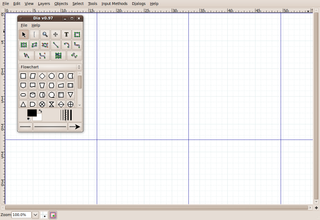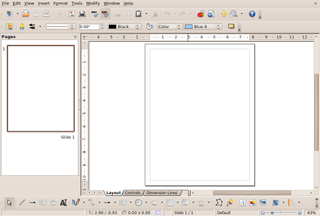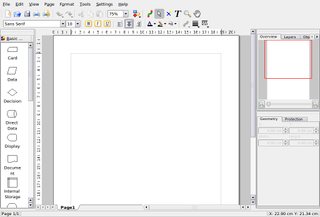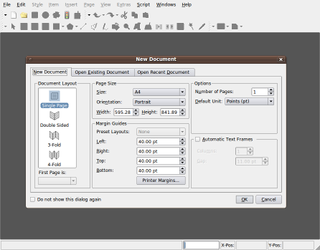Tom's Definitive Linux Software Roundup: Office Applications
Having covered Linux installation, running Windows XP in Ubuntu, Internet applications, and a handful of open source communications titles, Adam Overa is back with a comprehensive look at office apps for Windows users considering a switch to Linux.
Diagrams And Desktop Publishing
Diagrams
This is a collection of applications that create visual aides, such as flowcharts. Though Visio compatibility was not a requirement, it would be the Microsoft Office equivalent application in this instance.

Dia (v.0.97)
Dia is part of the GNOME Office suite. Even though the suite is a loose collection of unrelated applications, some of them are great. Dia is one of them. As its name obscurely suggests, this app is fantastic at creating diagrams of all kinds.
Instead of trying to fit a diagram-making app into an office app world, Dia takes the unique, yet completely logical, graph paper approach to diagram creation. The main window of Dia is a large, seemingly never-ending sheet of graph paper. The gridlines of the graph paper backing really help to place objects where you want them in relation to each other. The rendering of objects on the screen is very responsive as well--no lag or choppy lines, even in a VM. Dia is also great for flowcharts. Though not as user-friendly as Kivio, it gives the user more control.

Now, I'm no fan of apps that use multiple windows--by now that should be clear. Split-panes, tabs, or even a toolbar would work better with Dia than its undockable tool window. Hopefully the developers will use one of them in a future release. Window management aside, Dia is superb; the best app for diagramming.





OpenOffice.org Draw (v.3.1.1 b9420)
Stay on the Cutting Edge
Join the experts who read Tom's Hardware for the inside track on enthusiast PC tech news — and have for over 25 years. We'll send breaking news and in-depth reviews of CPUs, GPUs, AI, maker hardware and more straight to your inbox.
Draw is part of the OpenOffice.org FOSS office suite. OO.o Draw is primarily a diagram-making tool, but charts and diagrams aren't the application's only functions. It doubles as a simple desktop publisher as well. Draw is perfectly capable of creating basic fliers along with presentation aides, like flowcharts.
Each ODF drawing file (.odg) can contain multiple slides or pages. This allows you to create several different types of documents related to the same project and save them all in a single file. The interface is prettty straightforward, with a vertical left pane showing all the slides and a larger right pane displaying the current one.
The only thing to get used to in Draw is the object toolbar being on the bottom, away from the rest of the tools and menubar. Basically, Draw is good for light desktop publishing or simple diagraming. If you need more proffessional desktop publishing, go with Scribus. If you need flowcharts, look at Kivio.









Kivio (v.1.6.3)
Kivio is the diagram component of the KOffice suite. This application is tailored toward creating flowcharts with simplicity and ease-of-use in mind. If you've never made a flowchart before, you should be able to create one within minutes using Kivio.
The interface is similar to that of a word processor, or any other office app. The addition of a vertical, left-hand pane contains the different flowcharting objects that you can add to the document. Kivio is a great, user-friendly flowchart application, but mot much more.



Desktop Publishing
Now, unlike database apps, I personally have used desktop publishing software extensively. Microsoft Publisher is one app that I somewhat miss from my days using Windows, even though I have almost no need for creating printed materials these days.
So, I'll be looking at Scribus from the perspective of someone who has created almost every type of flyer, menu, coupon book, place holder, greeting card etc. in Microsoft Publisher (97, 2000, and 2003).

Scribus (v.1.3.3.12)
Scribus is pretty much the only desktop publishing application for Linux--certainly the only one that falls within the criteria for this roundup. Fortunately, Scribus is highly regarded as being quite capable to both the FOSS community and to Windows users alike.
After installing Scribus, I set out to quickly create a greeting card to get a feel for what kind of editing tools and options Scribus offers above-and-beyond those of a word processor.






The first thing that struck me about the Scribus interface was how Spartan it appears. This app looks more like a word processor than it does MS Publisher.
Scribus only comes with a handful of templates, but there is an 'extra template' package available, which easily quadruples that number. Unfortunately, none of the templates included address greeting cards. Also, I could not find a way to open a new document from a template immediately after starting Scribus. As far as I can tell, you must already have a document open so that you can choose New from Template in the file menu.
The exporting options are a little better. Scribus lets you export your document as a number of image formats, including PNG and SVG, as well as PDF. This is good. These outputs let anyone see your work using tons of apps they already have. The way Scribus handles images within the editor is another story. Instead of resizing an image to fit inside any image boxes you define, it fits what it can of the image into the image box. To edit the image, Scribus opens Gimp. Although Scribus is a good effort toward FOSS desktop publishing, I still miss MS Publisher.
Current page: Diagrams And Desktop Publishing
Prev Page Database Next Page Calendars And Address Books-
ksa-_-jed And don't bother looking for any anti-virus becuase you don't need it or cracks for your software becuase almost all app are free !!!!!!!Reply -
DjEaZy ... for my laptop @ work the only licensed thing are win7hp and KAV... all other apps are free... infrerecorder, inkskape, OOo and so on...Reply -
bloody llama Open Office and the other open source software are great for what they are, but try replacing Access 2007 or 2010 with something open source, and you'll be tearing your hair out.Reply -
jsowoc I assume that OO 3.0.1 is what you have in the repositories - was that the reason for testing the older version (version 3.2 came out two months ago)?Reply -
JonathanDeane bloody llamaOpen Office and the other open source software are great for what they are, but try replacing Access 2007 or 2010 with something open source, and you'll be tearing your hair out.Reply
This is very true, I love Open Office and for my home use it does 100% of what I would use MS Office for, that being said if I had to run a business on it I am afraid it would be worth it to pony up the dough for an MS product. -
ejmarkow Tom's Hardware omitted the best performing, most comprehensive, free and Open Source Accounting ERP software available for download. It's called "xTuple ERP PostBooks Edition" and utilizes PostgreSQL. This software is capable of running anything from a small to large business. Link: http://www.xtuple.orgReply -
killerclick We installed Linux and OOo into one of our offices (sort of an experiment to cut costs) and it was a riot. Not that Linux and OOo are bad, it's just that the power of habit is too strong to break when Windows and Linux are concerned. Windows and OS/X... not so much apparently.Reply -
Open Source is the future. ...... companies that profit millions or billions off of proprietary software. They are what hold us back.Reply
-
randomizer killerclickWindows and OS/X... not so much apparently.Well it's not like Office on Windows and Mac are vastly different, I'd hope that users would feel comfortable using the exact same software...Reply
I must attest to the uselessness of OOo Calc though. It needs a ground-up rewrite. It's slow to load and process even a small to moderately sized amount of data and charts are slow to redraw when altered. I have not tested GNUMeric enough to comment on that but it's supposedly alot faster.
I'm interested in looking at those project management programs. There's also OpenProj to add to the list. -
haplo602 hmm ... not my area of software, I try to avoid office apps as much as I can, but last time I worked in Writer/Calc it was slow and unresponsive. The best thing in Writer was the TeX like equation editor, way better than what MS had to offer. I think they made some progress on OOo since that time, so I'd have to test.Reply
Most Popular

